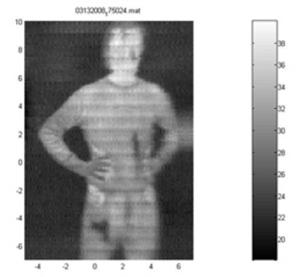Passive millimeter-wave technology promoted as solving privacy, health concerns
There are three leading technologies in whole-body scanning: backscatter X-ray, active millimeter wave, and passive millimeter wave; the first raises privacy issue; the second raises health concerns; Florida-based Brijot, a champion of passive millimeter wave, says its technology addresses both sets of concerns

Passive millimeter wave scan image // Source: nist.gov
Two years we ago a Florida-based company, Brijot Imaging Systems, Inc. which specializes in millimeter wave technology, caught our eye. We wrote that “One of the promised benefits of millimeter wave technology is its ability to scan from distance making it particularly attractive in areas where human traffic is a problem for traditional screening methods” (“Company Profile: Brijot Imaging Systems,” 26 March 2008 HSNW).
The other week on Capitol Hill, Frankie Guerrero, Brijot’s vice president of operations, demonstrated a new full-body scanner to lawmakers and homeland security officials in the basement of the Rayburn House Office Building.
As is the case with many other companies in the security scanning business, Brijot is hoping to get a share of a lucrative market boosted by new worries about air travel security following the Christmas Day 2009 incident near Detroit.
Since the botched attack, DHS announced it would invest heavily in advanced imaging technology to screen air passengers for similar threats metal detectors don’t find. The department’s fiscal year 2011 budget request asks for approximately $215 million to purchase 500 full body scanners. On Thursday, DHS secretary Janet Napolitano announced that the department deployed full body scanners at 11 additional domestic airports.
Matthew Harwood writes that Brijot hopes its new imaging system, known as SafeScreen, will detect threats while alleviating fears of full-body scanners among the traveling public. Bob Daly, chief technology officer for Brijot, told Harwood that the company’s its full-body scanner nullifies health concerns while providing better detection capabilities. Harwood notes that the difference between Brijot’s full-body scanner and its competitors’ rests in the underlying technology. Brijot’s system relies on passive millimeter wave technology, which detects differences in temperature between a person being screened and the objects he carries. The image generated by the machine looks like a gray and white thermal image set against a black backdrop, which makes it difficult to determine even the sex of the person being screened.
“If a powder/liquid is in a plastic bag and taped to your body in a way that it follows your natural contours, it can be difficult for backscatter and active millimeter wave technologies to identify that anything is amiss,” Daly said. “This is because those technologies are looking at the reflection of energy off of the body, seeing if there are any shapes on your body that do not belong.”
Brijot’s passive millimeter wave technology differs from the two
